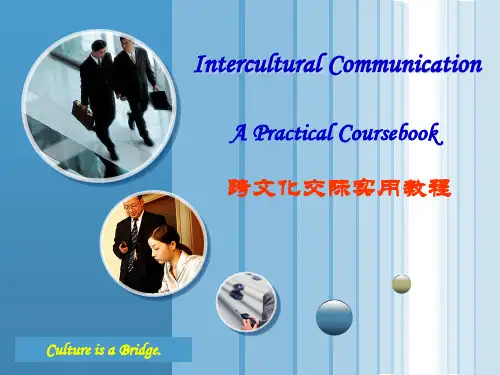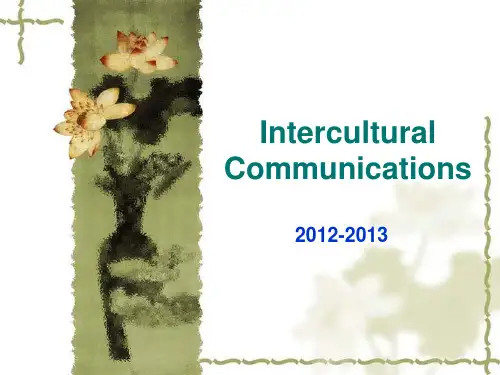跨文化交际实用教程胡超编著Unit 1
- 格式:ppt
- 大小:4.40 MB
- 文档页数:55
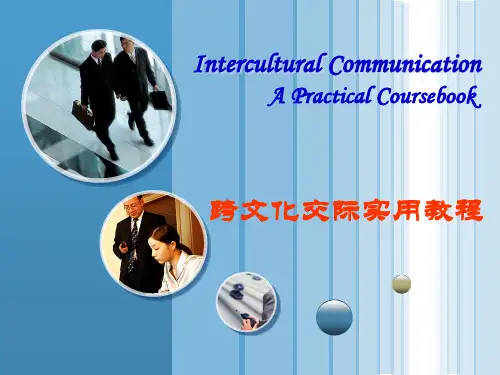

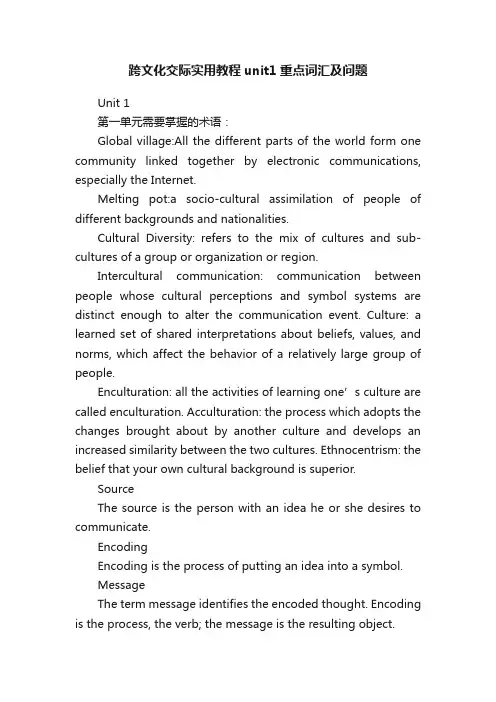
跨文化交际实用教程unit1重点词汇及问题Unit 1第一单元需要掌握的术语:Global village:All the different parts of the world form one community linked together by electronic communications, especially the Internet.Melting pot:a socio-cultural assimilation of people of different backgrounds and nationalities.Cultural Diversity: refers to the mix of cultures and sub-cultures of a group or organization or region.Intercultural communication: communication between people whose cultural perceptions and symbol systems are distinct enough to alter the communication event. Culture: a learned set of shared interpretations about beliefs, values, and norms, which affect the behavior of a relatively large group of people.Encul turation: all the activities of learning one’s culture are called enculturation. Acculturation: the process which adopts the changes brought about by another culture and develops an increased similarity between the two cultures. Ethnocentrism: the belief that your own cultural background is superior.SourceThe source is the person with an idea he or she desires to communicate.EncodingEncoding is the process of putting an idea into a symbol.MessageThe term message identifies the encoded thought. Encoding is the process, the verb; the message is the resulting object.ChannelThe term channel is used technically to refer to the means by which the encoded message is transmitted. The channel or medium, then, may be print, electronic, or the light and sound waves of the face-to-face communication.NoiseThe term noise technically refers to anything that distorts the message the source encodes.ReceiverThe receiver is the person who attends to the message.DecodingDecoding is the opposite process of encoding and just as much an active process. The receiver is actively involved in the communication process by assigning meaning to the symbols received.Receiver responseReceiver response refers to anything the receiver does after having attended to and decoded the message.(信息接受者在收到并解码/理解信息之后所作出的反应)FeedbackFeedback refers to that portion of the receiver response of which the source has knowledge and to which the source attends and assigns meaning.(信息接受者所作出的反应中能让信息发送者收到并理解的那一部分)ContextGenerally, context can be defined as the environment in which the communication takes place and which helps define the communication.五、简答和案例分析1. What are the four trends that lead to the development of the global village?The four trends that lead to the development of global village are:1) Convenient transportation systems;2) Innovative communication systems;3) Economic globalization;4) Widespread migration(p.8-9)2. What are the three aspects where the cultural differences exist?The three aspects where the cultural differences exist are:1) the material and spiritual products people produce2) what they do 3) what they think3. What are the three ingredients of culture?The three ingredients of culture are:1) artifacts 2) behavior3) concepts (beliefs, values, world views…)4. How to understand cultural iceberg?Just as an iceberg which has a visible section above the waterline and a larger invisible section below the waterline, culture has some aspects that are observable and others that can only be suspected and imagined. Also like an iceberg, the part of culture that is visible is only a small part of a much bigger whole. It is said nine-tenth of culture is below the surface. (pg. 7)5. What are the characteristic of culture?1) Culture is shared,2) Culture is learned,3) Culture is dynamic,4) Culture is ethnocentric.6. What are the characteristic of communication?1) Communication is dynamic2) Communication is irreversible3) Communication is symbolic4) Communication is systematic5) Communication is transactional. (pg. 8)6) Communication is contextual. (pg. 8)7. How is Chinese addressing different from American addressing?1) In China, the use of given names is limited to husband and wife, very close friends, juniors by elders or superiors, while more English-speaking people address others by using the first name, even when people meet for the first time.2) Chinese often extend kinship terms to people not related by blood or marriage. These terms are used after the surname to show politeness and respect. (pg. 23), but The English equivalents of the above kinship terms are not so used.3) In Chinese, people use a person’s title, office, or profession in addressing people. In English, only a few occupations or titles are used .8. How is the Chinese writing style different from the American style?1) Some oriental writing…is marked by what may be called an approach by indirection. In this kind of writing, the development of the paragraph may be said to be ‘turning and turning in a widening gyre.’The circles or gyres turn around the subject and show it from a variety of tangential views, but the subject is never looked at directly. Things are developed in terms of what they are not, rather than in terms of what they are.”2) An English paragraph usually begins with a topic statement, and then, by a series of subdivisions of that topic statement, each supported by example and illustrations,proceeds, to develop that central idea and relate that idea to all other ideas in the whole essay, and to employ that idea in it proper relationship with the other ideas, to prove something, or perhaps to argue something.”9. What are the different features of M-time and P-time?回答时注意:Monochronic 和Polychronic 两项都要列举几条,八条不用都回答上,但是第一条一定要回答上。
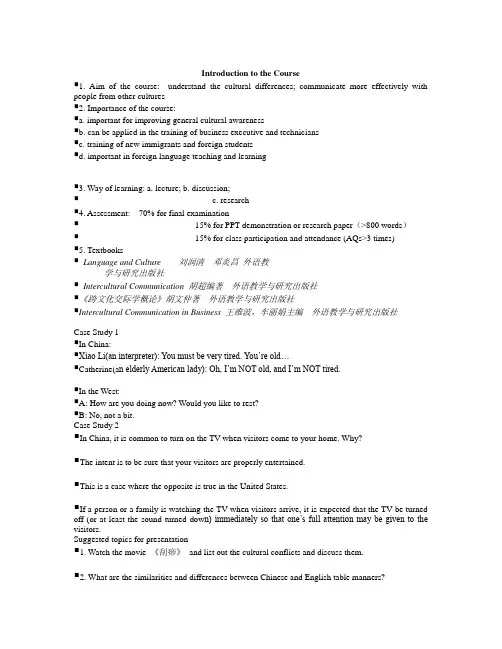
Introduction to the Course▪1. Aim of the course: understand the cultural differences; communicate more effectively with people from other cultures▪2. Importance of the course:▪a. important for improving general cultural awareness▪b. can be applied in the training of business executive and technicians▪c. training of new immigrants and foreign students▪d. important in foreign language teaching and learning▪3. Way of learning: a. lecture; b. discussion;▪ c. research▪4. Assessment: 70% for final examination▪15% for PPT demonstration or research paper(>800 words)▪15% for class participation and attendance (AQs>3 times)▪5. Textbooks▪Language and Culture 刘润清邓炎昌外语教学与研究出版社▪Intercultural Communication 胡超编著外语教学与研究出版社▪《跨文化交际学概论》胡文仲著外语教学与研究出版社▪Intercultural Communication in Business 王维波,车丽娟主编外语教学与研究出版社Case Study 1▪In China:▪Xiao Li(an interpreter): Y ou must be very tired. Y ou’re old…▪Catherine(a n elderly American lady): Oh, I’m NOT old, and I’m NOT tired.▪In the West:▪A: How are you doing now? Would you like to rest?▪B: No, not a bit.Case Study 2▪In China, it is common to turn on the TV when visitors come to your home. Why?▪The intent is to be sure that your visitors are properly entertained.▪This is a case where the opposite is true in the United States.▪If a person or a family is watching the TV when visitors arrive, it is expected that the TV be turned off (or at least the sound turned dow n) immediately so that one’s full attention may be given to the visitors.Suggested topics for presentation▪1. Watch the movie 《刮痧》and list out the cultural conflicts and discuss them.▪2. What are the similarities and differences between Chinese and English table manners?▪3. What are the taboos related to Chinese Spring Festival and English Christmas?4. Find a copy of English menu and explain it to the class.▪5. Role-play a job interview with your partner.▪6. Compare English and Chinese humor.Unit One IC, Culture, Language and CommunicationUnit 1 Intercultural Communication1.1 Definition of intercultural communication▪It refers to the communication between different cultural backgrounds.▪a phenomenon (跨文化交际) –universal, long existed▪a discipline(跨文化交际学)--first started in the United States. 1959, Edward Hall ―The Silend Language‖ immigrants, foreign students and tourist multi-national and transnational companies1.2 Components of intercultural communication▪a. International communication:▪e.g. Japanese Prime Minister〈--〉American president (this is the communication between two nations)▪b. interracial communication: e.g. Afro American 〈--〉White American▪c. inter-ethnic communication e.g. Tibetan〈--〉Han (they are from different ethnic groups)▪d. inter-regional communication: e.g. A northerner 〈--〉A Southerner1.3 Reasons for the increased intercultural communication▪1. Mobile means of transport▪2. Easy and convenient communication channel▪3. Globalization of world economy.▪4. Mass migration.1.4 Three contributors to successful intercultural communication▪(1) the positive feeling we possess at the affective level, inc luding affirmation, self-esteem, comfort, trust, and safety;▪(2) the beliefs we bring into the intercultural encounter at the cognitive level, inc luding expectations, stereotypes, uncertainties, and misunderstanding of rules or procedures;▪(3) the actions or skills we possess at the behavioral level, including verbal and nonverbal communication skills in intercultural settings.Section 2. Culture2.1 The importance of adequate knowledge of culture▪1. it is necessary for the survival and existence of human beings as human beings.▪Evidence: (1) Wild boy of A veyon (2) wolf children of India▪Victor of Aveyron (also The Wild Boy of Aveyron) was a boy who apparently lived his entirechildhood naked and alone in the woods before being found wandering the woods in France in 1797. ▪wolf children, also known as wild children, are children who've grown up with minimal human contact, or even none at all. They may have been raised by animals (often wolves) or somehow survived on their own. In some cases, children are confined and denied normal social interaction with other people.3▪2. It is necessary in learning a foreign language. In a way, learning a foreign language is learning a foreign culture. It is significant to get the acquaintance with cultural differences and understanding target culture▪Examples: cases of misunderstandings between people from different culturesCase Study 3▪Here is a story of Litz, a Finnish and her Chinese husband.▪Here is the conversation:Litz: Dick, how long is your mum going to stay?Dick: I don’t know. I haven’t asked her.Litz: Why not ask her?Dick: What do you mean by asking her?Litz: I mean what I said. Just ask her how long she’s going to stay.▪Can you diagnose the problem in the communication?Case Study 4▪Jonathan: Ann, your English is improving.I’m pleased with your wor k.▪Ann: (Looking down) Oh, no. My Englishis not very good.▪J: Why do you say that, Ann? Y ou’redoing very well in class.▪A: No. I am not a good student.Continued:▪J: Ann, you’re making progress in this class.Y ou should be proud of your English.▪A: No, it’s not true. Y ou are a good teacher, butI am not a good student.▪Now predict Jonathan’s feeling.▪J: (He is surprised by her response and wonders why she thinks her English is so bad. He doesn’t know what to say and wonders if he should stop giving her compliments.)Continued:▪Question 1: Where do they come from?▪Question 2: Why did Jonathan feel like that?▪Question 3: If Ann is an American girl, what would she respond to Jonathan?Another conversation:▪Jonathan: Ann, your English is improving.I’m pleased with your work.▪Ann: (making eye contact) Thank you. I’ve learneda lot in this course.▪J: Y ou’re doing well and I can really see progress.▪A: I enjoy studying English. I do homework everynight.▪J: I can see that. Keep up the good work.▪A: I’ll try. Y ou are a good teacher. Y ou have helpedme a lot.▪Discussion: Did you ever experience misunderstanding in your communication with a foreigner? Or did you read anything about this? Please describe the situation and analyze the reason.2.2. Different interpretations of culture▪a.我没文化,不识字。
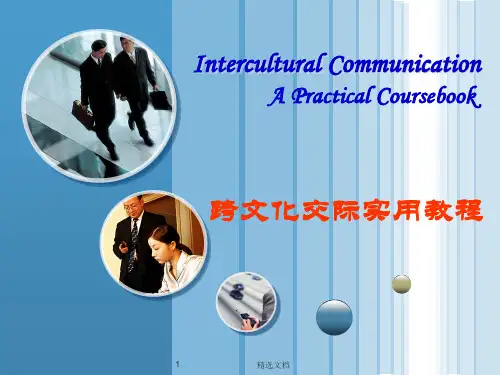
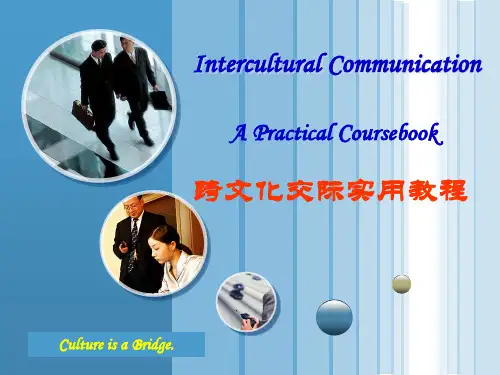

T 1 As a phenomenon, intercultural communication has existed for thousands of years. However, as a discipline, itshistory is only about fifty years.作为一种现象,跨文化交际已经存在了几千年。
然而,作为一门学科,它的历史只有50年左右。
F 2 Intercultural Communication as a discipline first started in Europe.跨文化交际作为一门学科最早起源于欧洲。
F 3 Culture is a static entity while communication is a dynamic process.文化是一个静态的实体,交流是一个动态的过程。
T4 Culture can be seen as shared knowledge ,what people need to know in order to act appropriately in a given culture.文化可以看作是共享的知识,人们需要知道什么才能在特定的文化中采取适当的行动。
T5 Although cultural stereotype has its limitations (over-generalization),it still contributes to a person ’s cultural cognition.虽然文化刻板印象有其局限性(过度概括),但它仍然有助于一个人的文化认知。
T 6 In intercultural communication, we should separate one ’s individual character from cultural generalization.在跨文化交际中,我们应该把一个人的个性与文化泛化区分开来。
